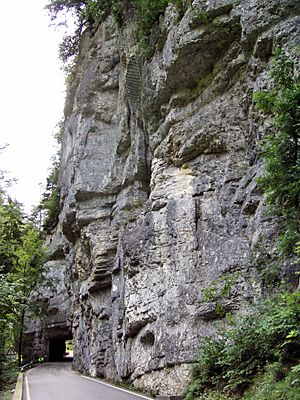Delémont District facts for kids
Quick facts for kids
Delémont District
District de Delémont
|
||
|---|---|---|
|
District
|
||
|
||
| Country | ||
| Canton | ||
| Capital | Delémont | |
| Area | ||
| • Total | 303.10 km2 (117.03 sq mi) | |
| Population
(2020)
|
||
| • Total | 38,954 | |
| • Density | 128.519/km2 (332.862/sq mi) | |
| Time zone | UTC+1 (CET) | |
| • Summer (DST) | UTC+2 (CEST) | |
| Municipalities | 19 | |
The Delémont District (also known as Delsberg in German) is one of the three main areas in the canton of Jura, Switzerland. It's like a county or a region within a larger state. The main city and capital of both the district and the canton is Delémont.
Most people in the Delémont District speak French. As of 31 December 2020, about 38,954 people live here. The district covers an area of about 303 square kilometers (117 square miles).
Contents
Towns and Villages in Delémont District
The Delémont District is made up of 19 smaller towns and villages, which are called municipalities. Each municipality has its own local government.
| Coat of Arms | Municipality | Population (31 December 2020) |
Area km2 |
|---|---|---|---|
| Boécourt | 923 | 12.35 | |
| Bourrignon | 270 | 13.55 | |
| Châtillon | 485 | 5.31 | |
| Courchapoix | 446 | 6.39 | |
| Courrendlin | 3,631 | 11.09 | |
| Courroux | 3,313 | 19.74 | |
| Courtételle | 2,644 | 13.56 | |
| Delémont | 12,618 | 21.97 | |
| Develier | 1,371 | 12.47 | |
| Ederswiler | 118 | 3.31 | |
| Haute-Sorne | 7,167 | 71.04 | |
| Mervelier | 528 | 9.74 | |
| Mettembert | 108 | 2.34 | |
| Movelier | 415 | 8.08 | |
| Pleigne | 349 | 17.84 | |
| Rossemaison | 687 | 1.89 | |
| Saulcy | 255 | 7.86 | |
| Soyhières | 436 | 7.51 | |
| Val Terbi | 8,651 | 38.84 | |
| Total | 38,954 | 303.23 |
District Symbol: The Coat of Arms
A coat of arms is a special symbol for a family, city, or region. The Delémont District's coat of arms has a red background. On it, you can see a silver "crosier" (a hook-shaped staff, like a shepherd's crook) and six silver "coupeaux" (small hills). This design represents the district's history and landscape.
Who Lives in Delémont District?
This section tells us about the people living in the Delémont District. This is called demographics.
As of as of December 2020[update], the district has about 38,954 people. Most people, around 88.1%, speak French as their main language. About 4.5% speak German, and 2.4% speak Italian.
In 2008, about 49.2% of the population were male and 50.8% were female. Most residents were Swiss citizens. About 37.4% of the people living in Delémont District in 2000 were born there. Many others were born in the same canton or elsewhere in Switzerland. About 15.8% were born outside of Switzerland.
Many people in the district are married. There are also many single people, and some who are widowed or divorced. About 4,165 homes have only one person living in them. There are also 1,147 homes with five or more people.
The chart below shows how the population of Delémont District has changed over time:

Changes Over Time
Districts and municipalities in Switzerland can change their borders or merge. In 1978, the Jura Canton became separate from the Canton of Bern. At that time, Delémont District gained some land from its neighbor, Moutier District.
Over the years, some municipalities have joined together to form larger ones.
- On January 1, 2013, the towns of Montsevelier, Vermes, and Vicques became one new municipality called Val Terbi.
- Also on that day, Bassecourt, Courfaivre, Glovelier, Soulce, and Undervelier merged to create Haute-Sorne.
- Later, on January 1, 2018, Corban joined Val Terbi.
- Most recently, on January 1, 2019, Rebeuvelier and Vellerat merged into Courrendlin.
How the District is Governed
In Switzerland, people vote to choose their leaders and make decisions. This is called politics. In the 2007 federal election, the most popular political group in Delémont District was the Social Democratic Party (SPS). They received 42% of all the votes. Other popular parties included the Christian Democratic People's Party (CVP) and the Swiss People's Party (SVP).
Religion in the District
According to a survey in 2000, most people in Delémont District are Roman Catholic, making up about 74.1% of the population. Another 10.8% belong to the Swiss Reformed Church. There are also smaller groups of people who follow other Christian churches, Islam, Buddhism, and Hinduism. Some people do not belong to any church or religion.
Learning and Schools
Education is very important in Delémont District. About 34.7% of the adults have finished high school, and 8.8% have gone on to higher education, like a university or a specialized college.
The school system in the Canton of Jura works like this:
- Kids can go to Kindergarten for two years, but it's not required.
- Then, they go to Primary school for six years.
- After that, they attend Lower Secondary school for three years. Here, students are grouped based on their skills and what they are good at.
- After Lower Secondary, students can choose to go to an Upper Secondary school for three or four years. From there, they might go to a university or start an apprenticeship to learn a trade.
During the 2009–10 school year, there were 3,381 students in 191 classes across the Delémont District. This included 795 kindergarten students and 2,586 primary school students.
See also
 In Spanish: Distrito de Delémont para niños
In Spanish: Distrito de Delémont para niños



